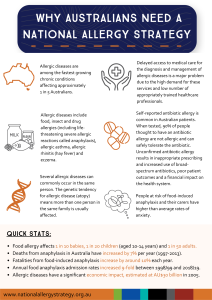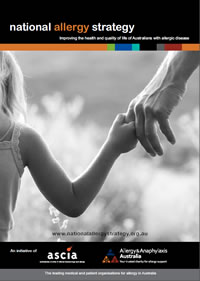National Allergy Strategy:

Allergic diseases are among the fastest growing chronic conditions affecting approximately 1 in 5 Australians.

Allergic diseases include food, insect and drug allergies (including life-threatening severe allergic reactions called anaphylaxis), allergic asthma, allergic rhinitis (hay fever) and eczema.

Several allergic diseases can commonly occur in the same person. The genetic tendency for allergic disease (atopy) means more than one person in the same family is usually affected. Allergic diseases are among the fastest growing chronic conditions affecting approximately 1 in 5 Australians.

Delayed access to medical care for the diagnosis and management of allergic diseases is a major problem due to the high demand for these services and low number of appropriately trained healthcare professionals.

Self-reported antibiotic allergy is common in Australian patients. When tested, 90% of people thought to have an antibiotic allergy are not allergic and can safely tolerate the antibiotic. Unconfirmed antibiotic allergy results in inappropriate prescribing and increased use of broad-spectrum antibiotics, poor patient outcomes and a financial impact on the health system.

People at risk of food-induced anaphylaxis and their carers have higher than average rates of anxiety.
Quick Stats
- Food allergy affects 1 in 10 babies, 1 in 20 children (aged 10-14 years) and 1 in 50 adults.
- Deaths from anaphylaxis in Australia have increased by 7% per year (1997-2013).
- Fatalities from food-induced anaphylaxis increase by around 10% each year.
- Annual food anaphylaxis admission rates increased 9-fold between 1998/99 and 2018/19.
- Allergic diseases have a significant economic impact, estimated at AU$30 billion in 2005.

- A reduction in the rate of food allergy in Australia.
- A reduction in the rate of deaths from anaphylaxis.
- A reduction in the economic and social costs of allergic disease.

- Drug allergies are properly identified, those who are not allergic are promptly “de-labelled” and documentation is robust.
- Accessible evidence-based allergy education for all healthcare providers. Education resources are sustained and supported.
- Uniform and high quality management of allergy and anaphylaxis across all health sectors including robust data about the incidence, causes and presentations of anaphylaxis via a register/notification scheme.

- The food service sector is well educated in food allergen management and is monitored appropriately to the highest standard.
- Food allergen labelling is logical, safe and useful.
- Increased support for research, particularly in relation to oral immunotherapy for food allergy to keep Australia at the forefront of allergy diagnosis and management.

- Access to quality allergy/immunology care is equitable and timely.
- Prompt and affordable access to life changing allergy treatments.
- Timely access to food challenges in a safe facility for everyone.

- A reduction in the rate of food allergy in Australia.
- A reduction in the rate of deaths from anaphylaxis.
- A reduction in the economic and social costs of allergic disease.
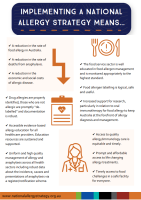
Download the ![]() Implementing the National Allergy Strategy.
Implementing the National Allergy Strategy.
Goal 1: Standards of Care
Develop standards of care to improve the health and quality of life of people with allergic diseases.
Goal 2: Access to Care
Ensure timely access to appropriate healthcare management for people with allergic diseases.
Goal 3: Information, Education and Training
Improve access to best-practice, evidence-based and consistent information, education and training on allergic diseases for health professionals, people with allergic diseases, consumers, carers and the community.
Goal 4: Research
Promote patient-focused research to prevent the development of allergic diseases and improve the health and quality of life of people with allergic diseases.
Goal 5: Prioritised Chronic Disease
Recognition of allergic diseases as a prioritised chronic disease and a National Health Priority Area.
Download the National Allergy Strategy
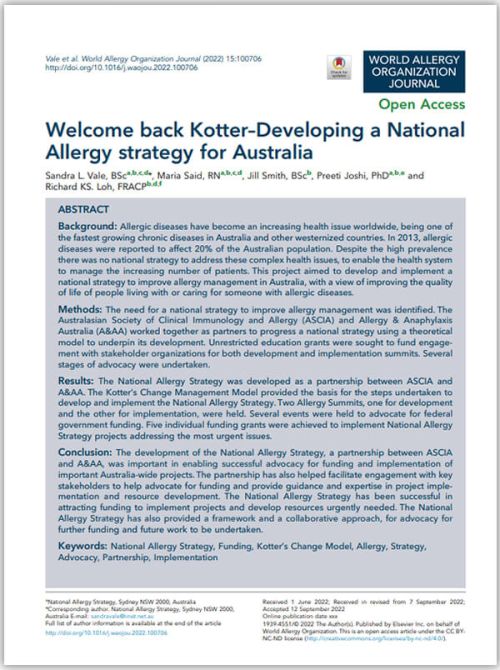
This paper details the development and implementation of the National Allergy Strategy, and the partnership and advocacy that have made it a success.
Welcome back Kotter - Developing a National Allergy Strategy for Australia is an open-access article published in the World Allergy Organization Journal.
![]() Welcome back Kotter-Developing a National Allergy Strategy for Australia 20221.11 MB
Welcome back Kotter-Developing a National Allergy Strategy for Australia 20221.11 MB
Introduction from Abstract
Allergic diseases have become an increasing health issue worldwide, being one of the fastest growing chronic diseases in Australia and other westernized countries. In 2013, allergic diseases were reported to affect 20% of the Australian population. Despite the high prevalence there was no national strategy to address these complex health issues, to enable the health system to manage the increasing number of patients. This project aimed to develop and implement a national strategy to improve allergy management in Australia, with a view of improving the quality of life of people living with or caring for someone with allergic diseases.

Approximately 2,900 people enroll in the 'All about Allergens' courses each month.

A recent study has shown that the annual rate of increase in infant anaphylaxis has slowed in those aged 1-4 and 5-9 years, indicating that the Nip allergies in the Bub project may be helping to reduce food allergy.

The Allergy 250K school aged teen camps increased participants confidence in food selection by 62% and confidence to tell an adult about their allergy by 67%.

Developed and launched the first Best Practice Guidelines for anaphylaxis prevention and management in schools and children’s education and care (CEC) services.

The four 'All about Allergens for Hospitals' courses have an average of 850 course enrolments per month.

The My Health Record project reached 115 ASCIA members and 85% reported that they understood the main features and functionality of MHR after the sessions.
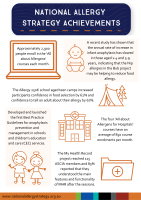
Download the ![]() National Allergy Strategy Achievements.
National Allergy Strategy Achievements.
Content updated October 2022
